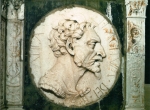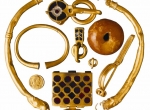Attila
Attila, king of the →Huns , ruled 434-453. After the death of king Rua power was assumed by his two nephews, A. and Bleda. When Bleda was murdered, starting from 445, A. became the sole ruler of the Huns, in their state in northern Pannonia, between the Danube and the Drava. The Huns had been settled there by Aëtius in exchange for the assistance in destroying the state of the →Burgundians on the Middle Rhine. From the beginning of his rule young A. believed that he could become a world ruler and acted accordingly. He regularly raided the Balkan provinces of the Eastern Roman Empire and in 447 took his forces as far as Thermopylae, captured a hundred cities in Thrace and threatened Constantinople itself, its walls destroyed that year by an earthquake. A. demanded tribute; during the 440s the →Huns would receive from Byzantium approximately thirteen thousand pounds of gold.
In 449 a Byzantine embassy was sent to A., one of its members Priscus of Panium, secretary to one of the envoys. Priscus described the journey and the course of the embassy. Its aim was to prevent war with A., which he threatened to wage on Byzantium. Passing through Serdica (Sofia) and Naissus (Niš), the envoys arrived in the Hunnic capital in Pannonia, at an unspecified location. After visiting the court of Kreka, one of A. wives, the envoys were received by the king himself and his eastern Germanic commanders. Priscus describes the appearance of the wooden hall where the feast was held, the furniture, the order of the feast and A. himself, whose dress in comparison to that of other persons present at the feast was simple and clean. The account given by Priscus, full of detail, offers a rare opportunity for comparison with the findings from archaeological research, especially that organic materials, including wood, only exceptionally survive to be excavated.
Before long A. started to prepare for war with the Western Roman Empire. He turned against it and set out for Gaul in 451 under the pretext of wishing to interfere in the dispute over the succession to the throne of the Ripuarian →Franks , having been insulted also by the refusal, on two occasions, of Valentinian III to give him his sister Justa Grata Honoria in marriage. Thirty thousand warriors entered Gaul: next to →Huns , also →Ostrogoths , Alans, →Gepids, Scirii, Rugii, Burgundians→ and →Thuringi. Their opponent was Aëtius; his small army was reinforced by Ripuarian and Salian →Franks , →Burgundians, Saxons and those Alans who had not set off in 409 for Spain with the →Vandals and a greater part of their own people. The main ally of Aëtius were →Visigoths who at this time resided in southern Gaul. On 20 June 451 on Catalaunian Plains on the river Marne near Troyes one of the greatest battles in the history of Europe was waged, its casualties, according to →Jordanes , numbering on both sides over sixteen thousand men. The account written around 550 by Jordanes is the only more complete record on this battle. Chaos reigned during the clash, the Visigoth king Theodoric I was killed, thrown from his horse and trampled by his own men. At night even Aëtius himself lost his way and strayed into the Hunnic camps and found his way back only with difficulty. A. expected the defeat and had a funeral pyre of horse saddles prepared for himself.
After losing the battle A. turned eastward and a year later invaded northern Italy, sacking Aquileia, Verona, Brescia, Bergamo and Milan. His plan to capture Rome fell through as the Hunnic forces were weakened by disease and a legation from Rome, with Pope Leo at its head, managed to persuade A. to withdraw from Italy.
After returning to Pannonia A. took young Ildico as his wife but died suddenly on his wedding night. He was given a magnificent burial, offered weapons, horse trappings set with precious stones, power insignia and other valuable items. This description brings to mind the offerings made to the dead practiced by the →Huns , known from archaeological finds e.g., from Szeged-Nagyséksós and Pannonhalma.
After the death of A. his many sons divided the kingdom among themselves but soon clashed with one another. Ardaric, king of the →Gepids, A.’s most loyal subject, made a coalition with →Ostrogoths , Rugii and Scirii and revolted against the Huns. In 454, or 455, in the Battle of Nedao, possibly a tributary of the Sava River, thirty thousand Huns were slain, A.’s eldest son, Ellac among them. Another son, Dengizich, was killed in Thrace, his head brought to Constantinople and displayed in a circus there.
In Pannonia the Huns were displaced by the Ostrogoths → who again defeated the Huns in 464 or 466, and Transylvania was occupied by the →Gepids. The last Hunnic raid from the Danube took place during the reign of Emperor Zeno (474-491), after which they disappear from the written record. Their remnants withdrew to Asia, and in western China and Kyrgyzstan graves have been discovered containing objects of Mediterranean character brought in from Europe.
For many centuries A. was a symbol of cruelty and extraordinary threat. He was known as the Scourge of God and the Sword of God (fig. 1.). As King Etzel he appears in the Song of the Nibelungs. A. was also depicted in several nineteenth century novels and engravings, and with time, in films, most notably in the 1954 production with Anthony Quinn as A. and Sophia Loren as Honoria.
MM
Literature: O. J. Maenchen-Helfen, Die Welt der Hunnen, Wien 1978; W. Menghin (ed.), Germanen, Hunnen und Awaren. Schätze der Völkerwanderungszeit, Nürnberg 1987; J-Y. Marin, Attila. Les influences danubiennes dans l’ouest de l’Europe au Ve siècle, Caen 1990; A. Krawczuk, Poczet cesarzy rzymskich. Dominat, Warszawa 1991, p. 518-525; A. Koch (ed.), Attila und die Hunnen, Stuttgart 2007; M. Mączyńska, Światło z popiołu. Wędrwówki ludów w Europie w IV i V w., Warszawa 2013, esp. p. 114-123, 138-142, 208-210.
-
 full resolution
full resolution
Fig. 1. A relief in Pavia Cathedral of Attila modelled on antique medallions, with an inscription Attila flagellum Dei - Scourge of God (J-Y. Marin 1990).
-
 full resolution
full resolution
Fig. 2. Grave goods from a warrior burial at Wolfsheim on the Middle Rhine with a nomad-style amber sword pendant (W. Menghin 1987).


